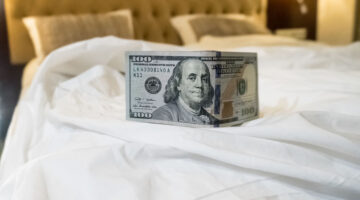How Do Men’s and Women’s Sexual Fantasies Differ?
February 29, 2012 by Justin Lehmiller
A few weeks back, I posted a Top 10 List of Sexual Fantasies, which contained a set of fun fantasies people have anonymously submitted to me over the years. As you read through the list, you probably found that it was easy to identify which fantasies were written by men (e.g., “Hot tub filled with whipped cream, pudding, and multiple blondes”) and which were written by women (e.g., “We’re out for a drive in the country and it starts to rain. We pull into the driveway at home and my partner pulls me into the barn, where we make love on a bale of hay as the rain continues outside”). A few fantasies were more challenging to place, but the majority of them were pretty simple because they largely conformed to gender stereotypes. So is this typically the case when it comes to sexual fantasies? Are men’s and women’s fantasies really that different?
Research has found that fantasy content differs in several ways between the sexes, and those differences are generally consistent with modern stereotypes [1]. First, men’s sexual fantasies are more sexually explicit than women’s. That is, not only are men’s fantasies more focused on the sexual act itself, but they frequently include mention of specific body parts (including pieces of their own and their partner’s anatomy). Second, women’s fantasies contain more in the way of emotional and romantic content than do men’s. Women frequently describe the setting of their sexual encounter in detail (e.g., on the beach or under the stars), as well as the “prelude” or build-up to sex (e.g., drinking champagne at a candlelight dinner before adjourning to the bedroom).
Third, men are more likely than women to fantasize about having several sexual partners at the same time (e.g., threesomes, “fourgys,” and sometimes many, many more!). Finally, the sexes also differ when it comes to fantasizing about dominance and submission. While men are equally likely to fantasize about being dominant and submissive, women seem to fantasize more about being submissive than dominant.
How does sexual orientation play into all of this? Do gays and lesbians have different fantasy content than their heterosexual counterparts? Seemingly not. Most research on this topic suggests that the only reliable difference between the fantasies of gay and heterosexual men and between lesbian and heterosexual women is the sex of the person(s) they are fantasizing about [2]. Thus, the same gender differences in fantasy content observed among heterosexuals also emerge when you compare gay men to lesbians.
In short, the fantasy worlds that occupy men’s and women’s minds are quite distinct and, while there is always a vast amount of individual variability, there appears to be at least a hint of truth to many of the gender stereotypes that exist regarding fantasy content.
Want to learn more about Sex and Psychology ? Click here for previous articles or follow the blog on Facebook (facebook.com/psychologyofsex), Twitter (@JustinLehmiller), or Reddit (reddit.com/r/psychologyofsex) to receive updates. You can also follow Dr. Lehmiller on YouTube and Instagram.
[1] Zurbriggen, E. L., & Yost, M. R. (2004). Power, desire, and pleasure in sexual fantasies. The Journal of Sex Research, 41, 288-300.
[2] Leitenberg, H., & Henning, K. (1995). Sexual fantasy. Psychological Bulletin, 117, 469-496.
Image Source: 123rf
You Might Also Like:

Dr. Justin Lehmiller
Founder & Owner of Sex and PsychologyDr. Justin Lehmiller is a social psychologist and Research Fellow at The Kinsey Institute. He runs the Sex and Psychology blog and podcast and is author of the popular book Tell Me What You Want. Dr. Lehmiller is an award-winning educator, and a prolific researcher who has published more than 50 academic works.
Read full bio >


